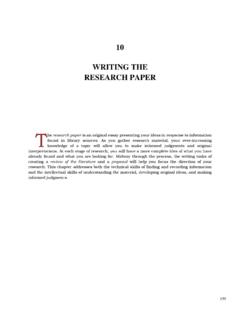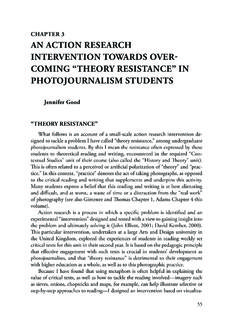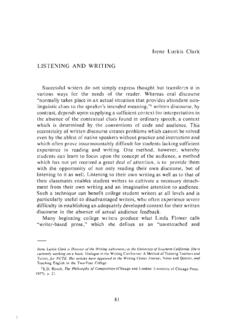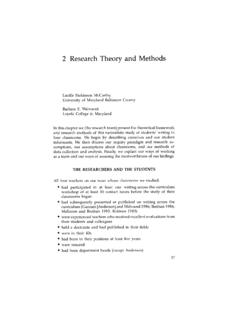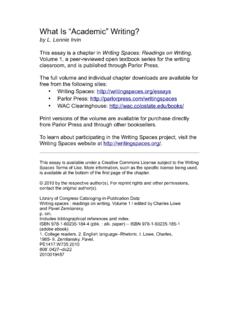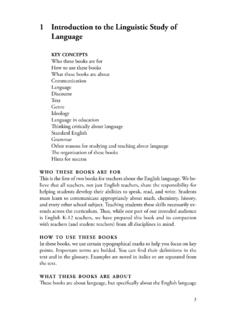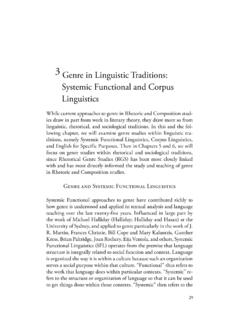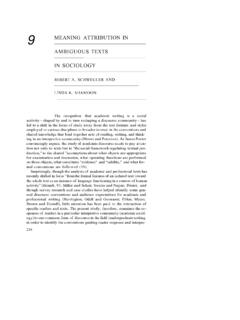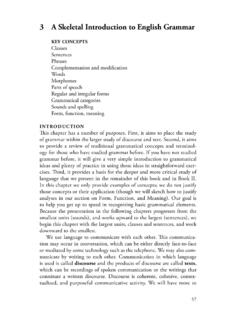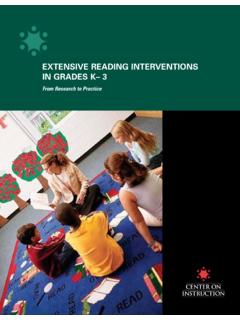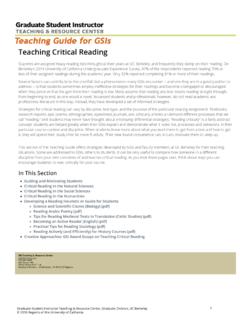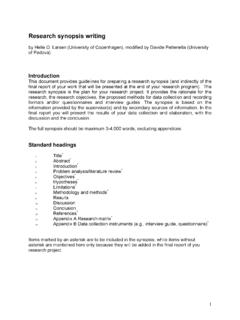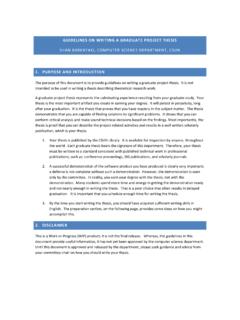Transcription of Note Taking and Learning: A Summary of Research
1 Note Taking and learning : A Summary of Research Fran oise Boch, Stendhal University, and Annie Piolat, University of ProvenceIntroduction The activity of note Taking can be considered part of Writing Across the Curriculum. It crosses over all disciplines and has the two characteristics of Writing Across the Curriculum: note Taking helps students learn, and note Taking helps students learn to write. Even though techniques for understanding and writing texts are widely taught and practiced throughout a student s school and university career, very few students are taught even basic note Taking skills. This despite the fact that students are expected to take extensive notes during their courses across the curriculum, and despite the recognized usefulness of note Taking for stor-ing, learning and thinking about what is being taught.
2 The functional complexity of note Taking has not been sufficiently ac-cepted by researchers and teachers, undoubtedly because the representation concerning the knowledge and skills it involves has been minimized. Too of-ten, note Taking is seen as the rapid transcription of information by using a few condensing techniques, such as shortened words and substitution symbols, for the creation of an external memory whose only importance will be its later use. The work presented in this article shows that we can go much further than this minimalist view. This paper provides an overview of the Research carried out in the fields of cognitive psychology, linguistics, and teaching science relevant to this specialized form of writing (see also, Piolat & Boch, 2004).
3 It briefly presents four aspects of note Taking : (1) the principal functions of note Taking : writing to learn ; (2) the main note Taking strategies used by students; (3) the different factors involved in the comprehension and learning of knowledge through note Taking ; (4) the learning contexts that allow effective note Taking : learning to write. 1. What are the functions of note Taking ? Note-takers take notes to fulfill two major functions: to record infor-mation and/or to aid reflection. Over and above the drawing up of a simple memory aid, such as a shopping list, or a record of actions, such as a diary, one of the major aims of note Taking is to build up a stable external memory in a form that can be used at a later date.
4 Confronted with a diverse range of in-formation-transmission situations, note-takers are striving to avoid forgetting 101something. Note Taking is an essential tool in many information-transmission situations. At the university level, which is the level we are interested in here, note Taking allows students to gather information from lectures, books, or any other situation that they will later have to memorize or use in order to success-fully complete their academic program. Storage methods vary from copy-re-gurgitate strategies, which have proven to be effective from a scholastic point of view, to more complex reformulation-interpretation strategies. These are less frequently used by students (Boch, 1999; Van Metter, Yokoi, & Pressley, 1994), probably because they are more risky: it is more difficult to faithfully reproduce the source information when this information has been reformulated rather than simply transcribed.
5 The use of note Taking to store transmitted information often over-shadows another important role reflection. Note Taking is an effective infor-mation-processing tool that is commonly used both in daily life and in many professions (Hartley, 2002). As such, it contributes to the carrying out of a range of intellectual processes, such as making judgments, resolving issues, and making decisions. The Taking of notes can aid time-consuming, real-time thought processes, such as the resolution of mathematical problems. In this respect, notes are similar to a rough draft in that they allow information to be coded, thereby relieving mnemonic processes and consequently helping with the development of the solution (Cary & Calson, 1999).
6 Primary schools, secondary schools, and universities provide their students with no (or very little) help in acquiring the skills needed to success-fully develop these two essential write-to-learn functions: (1) Taking notes to stabilize the knowledge to be acquired and reproduced during course ques-tion type examinations and (2) Taking notes to effectively resolve problems, whether this is understanding complex documents, writing reports, or solving algebraic equations. 2. How are notes taken? The average writing speed of a student is around to words/second, whereas a lecturer speaks at a rate of around 2 to 3 words/second. Unless everything is said at dictation speed, or students develop exceptional shorthand skills, teachers will never speak slowly enough for students to write down everything that is said.
7 As a result, students intuitively develop process-es and methods that allow them to record the content of lessons. Without going into detail about the linguistic processes used, which are well known, such as the use of abbreviations, truncating long words, and apocopes, we would like to briefly look at the markers in a speaker s text that signal, more or less explicitly, the importance of what is being said. Note-takers are very attentive to these markers, which have a considerable influence on the quantity of notes taken. 102 The WAC JournalNote Taking and learning : A Summary of Research 103 The indicators that trigger note Taking , identified by several Research studies using quantitative methods (Boch, 1999; Branca-Rosoff & Doggen, 2003) are the following:Writing on the board: a very powerful indicator.
8 (Teachers are well advised to choose what they write on the board carefully, as it s extremely likely to be included in the note Taking !) Dictation : when the teacher acts as if he or she is dictating the informa-tion (slow delivery, low vocal register).A title of a section or a list or the listing of information (which, moreover, are often written on the board).Definitions, catch phrases. (Even if students don t understand them, they overwhelmingly take notes on them.)Macro-textual planning indicators that organize and structure the classes (expressions such as firstly / secondly or first question / second ques-tion ). All these indicators are very much tied to written communication. We can, moreover, assume that the information dealt with here has been subject to note Taking by the teacher beforehand.
9 The student intuitively recognizes it as important because the teacher has planned and often written it. Alongside these indicators that trigger note Taking , we can assume that some forms discourage note Taking . We consider the following as inhibiting indicators :Parentheses or asides: sequences that do not contribute to the organization of what is said and that we intuitively perceive as often being introduced with a lower intentional in class between the teacher and the students (responses by the teacher to students questions) or, worse, between phenomena, which are symmetrically opposed to those that char-acterize the trigger indicators: faster delivery, higher vocal indicators often accompany the asides, parentheses, and in speaking, which are probably signs that what is being said has not been planned by the paraverbal indicators.
10 When the teacher puts aside his or her notes or walks around the classroom, the student statistically takes less trouble to note what is being said at that time. The point in common with all these inhibiting indicators is that they are the product of a real, oral communication situation. Because of this, infor-mation considered not planned because not written is not taken into account by the student. Yet, we can assume that it s during these moments that com- 104 The WAC Journalprehension hangs in the balance: examples and explanations are given that could be useful to note. Teachers are therefore well advised, if they want such information to be taken down as notes, to say so explicitly to their students or use an explicit indicator such as careful, this is important!
